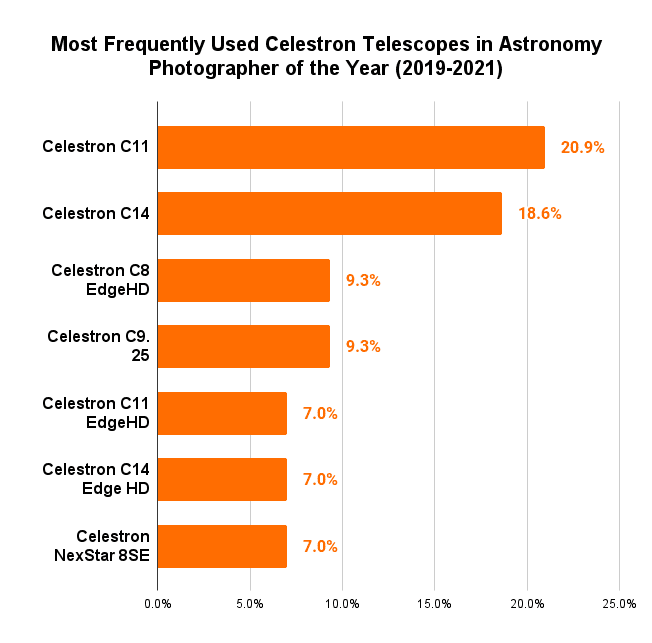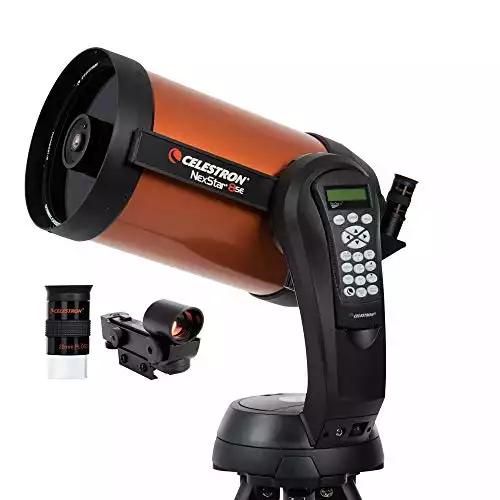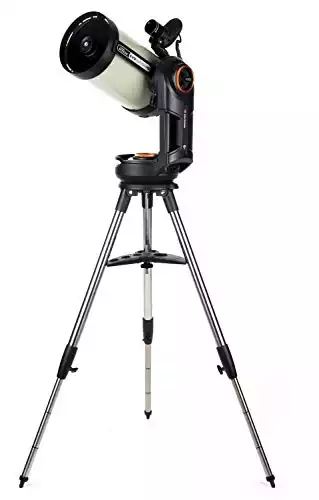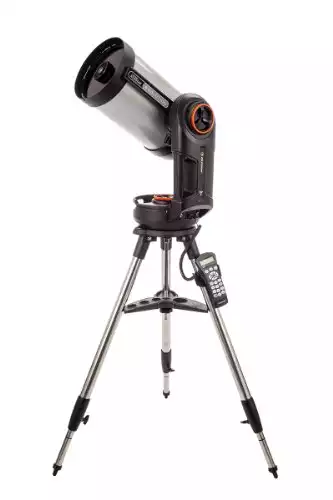Celestron Nexstar 8SE vs Evolution 8 vs 8 EdgeHD – what is the difference and what is best for you?
In this article we outline the key differences between these great telescope packages so you can work out which one to buy.
|
Make & Model:
Celestron NexStar 8SE
|
Make & Model:
Celestron NexStar Evolution 8
|
Make & Model:
Celestron NexStar Evolution 8 HD
|
|
Telescope type:
Schmidt-Cassegrain
|
Telescope type:
Schmidt-Cassegrain
|
Telescope type:
Schmidt-Cassegrain
|
|
Aperture:
8 inches (203 mm)
|
Aperture:
8 inches (203 mm)
|
Aperture:
8 inches (203 mm)
|
|
Focal length:
80 inches (2032 mm)
|
Focal length:
80 inches (2032 mm)
|
Focal length:
80 inches (2032 mm)
|
|
Focal ratio:
F/10
|
Focal ratio:
F/10
|
Focal ratio:
F/10 (convertible to F/2)
|
|
Mount Type:
Single Fork Arm Alt-Az
|
Mount Type:
Single Fork Arm Alt-Az
|
Mount Type:
Single Fork Arm Alt-Az
|
|
Mount capacity:
12 lbs (5.4 kg)
|
Mount capacity:
25 lbs (11 kg)
|
Mount capacity:
25 lbs (11 kg)
|
|
Tripod height:
38-56 inches (97-142 cm)
|
Tripod height:
47-69 inches (119-175 cm)
|
Tripod height:
47-69 inches (119-175 cm)
|
|
Total weight:
33 lbs (15 kg)
|
Total weight:
40.5 lbs (18 kg)
|
Total weight:
42 lbs (19 kg)
|
Celestron NexStar 8SE vs Evolution 8 vs EdgeHD: Similarities and Differences
First, let’s examine the core similarities and differences between these telescope packages.
OTA (Telescope)
All have an 8-inch (203 mm) aperture Schmidt-Cassegrain OTAs (Optical Tube Assembly – i.e. the telescope) with an 80-inch (2032 mm) focal length.
The Evolution 8 and NexStar 8SE OTAs are identical in everything apart from the color.
The EdgeHD OTA is different in a couple of ways that make it better for astrophotography:
- It has EdgeHD optics that correct for the spherical mirror used in all Schmidt-Cassegrain telescopes that produce distortion at the edges. This means that images and views are clear all the way to the edge in a way that they are not with regular SCTs.
- It has a removable secondary mirror that allows a camera to be attached directly to the front and improves the focal ratio from F/10 to F/2 (Celestion call this Fastar technology). An additional component called the Hyperstar is required.
The result of this is that the EdgeHD OTA can be significantly better for deep-sky imaging.
Mount & Tripod
All come with a computerized/GOTO alt-az mount that uses Celestron’s SkyAlign Technology to allow you to locate over 40,000 astronomical objects with a hand controller. However the mounts are different:
- The mount and tripod that come with the Evolution 8 and 8 HD is significantly sturdier and has a payload capacity of 25 lbs (11 kg).
- In contrast, the mount and tripod that comes with the Nexstar 8SE has a capacity of 12 lbs (5.4 kg)
These mounts are all alt-azimuth, which is best for visual observing but not astrophotography.
You can add Celestron’s equatorial wedge to convert them from alt-az to equatorial to improve performance for deep-sky imaging.
The 8 HD also comes with StarSense technology that polar aligns automatically.
WIFI
- The Evolution 8 and EdgeHD have in-built wifi capacity. This means that you can control them from your phone, tablet or similar using an app, rather than just the hand controller that comes as part of all the packages.
- The NexStar 8SE does not have this but an additional wifi module can be bought separately and added to give this functionality.
Battery
- The Evolution 8 and 8HD have an in-built battery that is USB rechargeable.
- The NexStar 8SE is powered by 8 AA batteries (that can get eaten up very quickly), a portable PowerTank, or AC power.
Weight & Height
- The 8SE is lightest at 33 lbs for the full package, versus 40.5 lbs for the Evolution 8 and 42 lbs for the 8HD.
- However, the tripod with the 8SE is shorter – it has a max height of 56 inches (142 cm) versus up to 69 inches (175 cm) for the Evolution 8 and 8 HD.
Cost
- Price can vary and fluctuate according to availability but in general the NexStar 8SE is the cheapest, followed by the Evolution 8, and the 8 EdgeHD is the most expensive.
Now let’s look at each of the models individually.
Celestron NexStar 8SE
The Celestron NexStar 8SE is the largest in the SE range (which also features, 6-inch, 5-inch, and 4-inch versions).
It’s one of the most popular telescope bundles in the world as you get an 8-inch telescope tube with a GOTO mount of manageable weight and size at a price that is good value.
This video from Celestron provides a quick overview of the key features of the NexStar range:
There are a number of pros and cons in comparison to the other two models we are comparing here:
Pros
- It is the same 8-inch OTA (telescope tube) that comes with the Evolution 8 package, yet is generally on sale for substantially cheaper and provides great value.
- It is the lightest.
Cons
- The mount is less sturdy than that coming with the other two telescopes, having just half the payload capacity.
- Although it weighs less, it lacks handles that make the other OTAs easier to carry, and the maximum tripod height is shorter.
- It lacks in-built wifi (although this can be added with Celestron’s wifi module).
- It needs AA batteries or an external power source to run if away from an AC power socket.
- Compared to the Evolution 8 EdgeHD it lacks the features that make that model excel for astrophotography.
Overall, this is a great value package that makes an advanced and powerful telescope accessible to beginners and more experienced users.
Key specifications
- Aperture: 8 inches (203 mm)
- Focal length: 2032 mm (80 inches)
- Focal ratio: F/10
- Weight: 33 lbs (15 kg)
- Mount: Computerized Altitude-Azimuth Single Fork Arm (12 lbs capacity)
- Tripod height: 38 to 56 inches (97-142 cm)
- Accessories: Star Pointer Finderscope, 25mm eyepiece, star diagonal
Celestron's most popular advanced GOTO telescope package
- Powerful 8-inch aperture
- Easy-to-use computerized mount finds objects for you to view at the press of a button
- All you need in one package, with telescope, mount, and tripod
- Price is kept down by the inclusion of the less-sturdy mount
- No built-in WIFI
Celestron Evolution 8
The Celestion NexStar Evolution range are the premium section of the NexStar range and this model has the same 8-inch Schmidt-Cassegrain OTA as the 8SE above (albeit in a different color).
However, it boasts a much sturdier mount and also features in-built WIFI so that it can be controlled by an app on your phone rather than the hand controller without having to buy any extra components.
It also has an in-built battery that you charge via a USB cable. This is a significant advantage as telescopes lacking this tend to eat AA batteries very quickly and is an issue if you want to use it away from an AC power supply.
It lacks some of the astrophotography advantages of the 8HD model below, but for visual astronomy they are essentially like for like.
In comparison to the models above and below:
Pros
- The 8-inch OTA combined with the sturdy mount make this a visual astronomy powerhouse.
- The in-built wifi and battery power source make it a true all-in-one package and eliminate the need to add many extra components.
- It comes with a tall and sturdy mount and tripod.
- It is cheaper than the HD model below (although check prices).
Cons
- For long exposures you will need to add the equatorial wedge to allow the mount to track equatorially and eliminate the field rotation that you get with alt-az mounts.
- It lacks the EdgeHD optics that correct the distortion seen in imaging with SCT telescopes and the Fastar capabilities of the 8HD model below. However, for visual observing this will make little difference.
Overall, this is a higher quality package for astronomy than the 8SE above, but this comes at a higher cost.
Key specifications
- Aperture: 8 inches (203 mm)
- Focal length: 80 inches (2032 mm)
- Focal ratio: F/10
- Weight: 40.5 lbs (18 kg)
- Mount: Computerized Altitude-Azimuth Single Fork Arm (25 lbs capacity)
- Tripod height: 47 to 69 inches (119-175 cm)
- Accessories: StarPointer finderscope, two 1.25” Plossl eyepieces, a 1.25” star diagonal, AC adapter
Celestron's Premium 8-inch SCT package
- Powerful 8-inch telescope provides high-quality views
- In-built wifi and battery power source make it a true all-in-one package
- Tall tripod and sturdy mount
- Relatively heavy
- Can be used for astrophotography but not specialized for this
Celestron Evolution 8 EdgeHD
The HD version of the Evolution 8 is tailored for astrophotography.
As noted above, the EdgeHD optics correct the distortion you get around the edges of images when using SCT telescopes and their curved mirrors.
Also, the Fastar technology allows you to remove the secondary mirror and attach your camera to the front, thereby massively speeding up the focal ratio from F/10 to F/2 (you need to add a Hyperstar lens to do this).
The astrophotography credentials of this telescope are also backed up by a study we did of hundreds of images shortlisted for the Astronomy Photographer of the Year competition.
The Celestron 8 EdgeHD was the third most successfully used Celestron telescope, behind only the larger 11-inch and 14-inch models:

It has the same sturdy tripod and mount as the model above, as well as the in-built wifi and battery power source.
See the quick highlights from Celestron here:
The positives and negatives of this over the models above are:
Pros
- It has features that tailor it for deep-sky astrophotography and this separates it from the regular 8-inch Evolution.
- It boasts the same tall and sturdy mount and tripod.
Cons
- It’s the most expensive and, at the time of writing, is the hardest to find in stock.
- Despite being designed for astrophotography, you will still need to add the equatorial wedge for long exposure deep sky imaging as otherwise the mount is just Alt-Az.
Overall, this is a great telescope package that gives you all you need for both observing and photographing space.
Key specifications
- Aperture: 8 inches (203 mm)
- Focal length: 80 inches (2032 mm)
- Focal ratio: F/10, but convertible to F/2
- Weight: 42 lbs (19 kg)
- Mount: Computerized Altitude-Azimuth Single Fork Arm (25 lbs capacity)
- Tripod height: 47 to 69 inches (119-175 cm)
- Accessories: Red dot finderscope, star diagonal, 40mm and 13mm eyepieces
Premium 8-inch Astrophotography Telescope Package
- Powerful 8-inch telescope
- EdgeHD optics optimized for astrophotography use
- In-built wifi and battery power source make it a true all-in-one package
- Tall tripod and sturdy mount
- Expensive
- Need to add an Equatorial Wedge to upgrade the mount
Other 8-inch Celestron Telescopes
There are also a few other Celestion 8-inch telescope OTAs and packages that are worth comparing to get the full overview.
In essence, there are three types of 8-inch Schmidt-Cassegrain OTA offered by Celestion:
- the C8 used in the 8SE and Evolution 8 (and CPC) which is primarily for visual astronomy
- the C8 HD which is for both visual observing and astrophotography
- the Rowe-Ackermann Schmidt Astrograph (RASA) 8 which is for astrophotography only
All can be bought as packages with different mounts or as standalone OTAs where you buy the mount separately (if you want to compare the best mounts, see our article on the Best Mounts for Astrophotography.)
Here is a quick overview of the differences and similarities between the different packages:
- Celestron CPC 800 – The same C8 8-inch SCT OTA as the 8SE and Evolution 8 models but has a dual-fork arm mount which is much more accurate in tracking.
- Celestion CPC 800 Deluxe HD – Deluxe/HD version of the CPC 800 is a combination of the 8 EdgeHD OTA with the dual form arm mount from the CPC 800 above.
- Celestron Advanced VX 8 – The same C8 OTA combined with the AVX equatorial mount.
- Celestron Advanced VX 8 Edge HD – The C8 HD OTA combined with the AVX equatorial mount.
- Celestion RASA 8 – The OTA of the 8-inch Celestron Rowe-Ackermann Schmidt Astrograph (RASA). It has an F/2 focal ratio – just like what the EdgeHD OTA can be converted to. However, it is an imaging-only telescope and cannot be used for visual observing, only astrophotography.
Verdict: Celestron Evolution 8 vs 8 HD vs NexStar 8SE
Prices can vary and fluctuate according to availability but in general the 8SE is the cheapest, followed by the Evolution 8, and then the 8HD is the most expensive.
This reflects the additional value that each model provides and it’s up to you to decide what is worth paying extra for:
- The 8SE is a great 8-inch telescope and a good value package but has a flimsier mount and needs a number of add-ons to give it some of the capabilities of the other models like wifi and lacks an in-built rechargeable battery.
- The Evolution 8 package is an upgrade from the 8SE because of the much sturdier mount and in-built features. If using for visual only and not astrophotography, you can also save some money versus the 8HD model.
- The 8HD is a significant upgrade for astrophotography. If this is your goal, then this is the best, but it will cost more.
These can also all be bought as standalone OTAs – Celestion C8 and Celestion 8 EdgeHD – and then combined with a standalone equatorial mount like the Celestion AVX, CGEM II or CGX.
You can also see here a broader overview of all Celestron NexStar models and for the most high-powered models, please also see our guide to the Most Powerful Telescopes you can buy.
Please let us know if you have any comments or questions below.









I found a major difference in the Nexstar Mount vs. the Evolution Mount was the Evolution has clutches for both axis. I just wish Celestron had included the GPS electronics like the CPC Mounts.
There are also versions of the 8SE that comes with farstar and versions of the 8SE that comes with Edge Optic.
Yes, you can get Celestron’s 8-inch OTA as an EdgeHD model or a RASA with a selection of different Celestron mounts. Thanks!